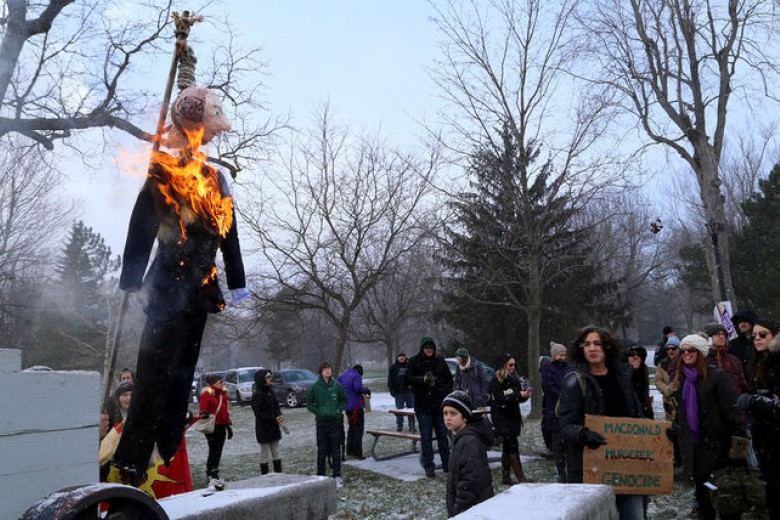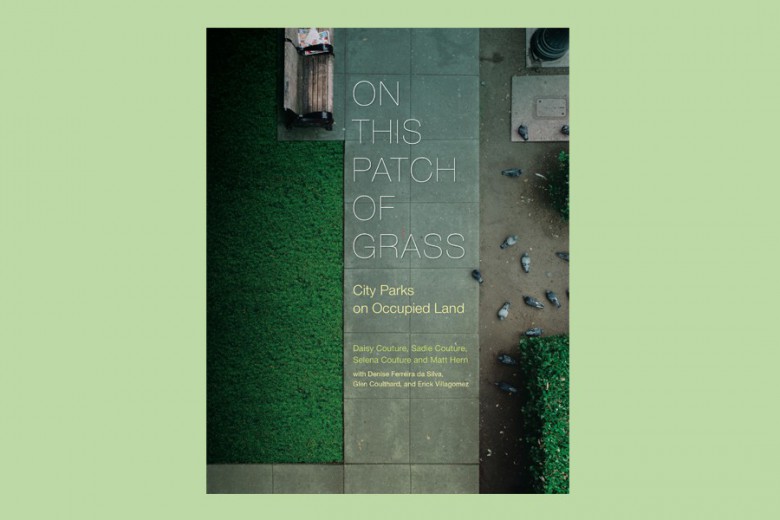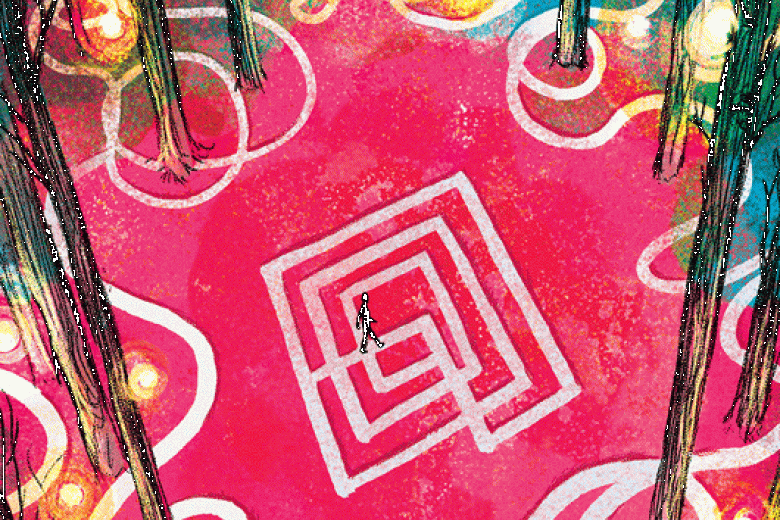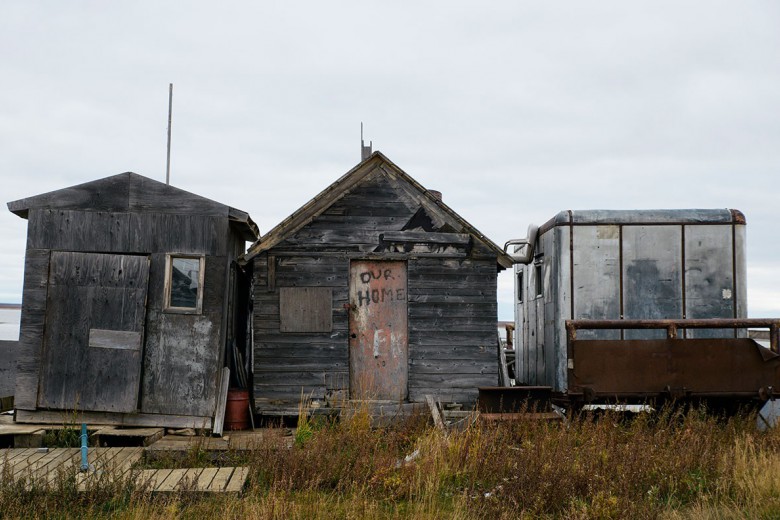From the unceded Syilx territories.
They say history does not necessarily repeat itself, but that it certainly does rhyme.
In the case of Ayotzinapa, the conductor of the macabre symphony, keeping that callous rhythm of history, is a reaper… and it goes by the name of Neoliberalism.
And because the discord of history still echoes much too loudly, a small group of students from the Okanagan Valley decided to organize – so we could hear something different.
The reasons why the students in the Okanagan Valley organized are both simple and complex, rooted in both the past and the present. What matters is that they did organize.
Tears and rage
On September 26, students from a rural college in Ayotzinapa who were learning to be elementary school teachers were gathering in Iguala, Guerrero (Mexico) to speak out. Upon mobilizing, the young students were met and encircled by police, and a confrontation ensued. Shots rang out resulting in the death of six students, as well as the injury of 25 more. After the police lowered their weapons and finished firing, another 43 students were corralled and forced into transport vehicles. 42 students are still missing, and the burnt remains of one, 19-year-old Alexander Mora Venancio, were found in a plastic bag near a river.
The others are thought to be dead and scattered amongst several mass graves that have recently been discovered across the Mexican countryside. Reports of drug cartel involvement, as well as collusion amongst narco-traffickers, elected officials, and local authorities are extensive. Speculation lingers in the aftermath, as well as uncertainty. What also remains are the tears, and rage, of their families.
The students of Ayotzinapa were gathering in Iguala to raise funds in order to travel to a memorial for the fallen students of the 1968 Tlatelolco (Mexico City) Massacre. They also wanted to speak out against discriminatory policies obstructing their ability to access education and institutionalized labour market exclusions that the Indigenous rural poor face in acquiring jobs as teachers. These issues mirror those faced by the slain students of 1968.
What prompted the students from Ayotzinapa to raise their voices is significant, because it underscores how the colonial violence of the past reverberates in the present. And the details regarding the 43 disappeared students resonate because they shed light on the trauma inflicted upon those who collectively resist such violence. In other words, the students from Ayotzinapa, most of whom were Indigenous and poor, were gathering to contest a racist government and its oppressive neoliberal reforms. And they were doing so knowing that in times past students much like themselves were met with bullets, batons, and bloodshed for speaking out.
But they showed up anyway, with dignity in their collective voice and resistance in their collective heart.
Colonial Histories, Colonial Geographies, and the Politics of Death
And yes, we are still talking about Mexico.
…Or are we?
The horrible machinations of colonially entrenched structures of governance and profit, which carry out the planned disappearance of Indigenous people and the elimination of their claims to land, culture, and language, are not unique to the tragedy of Ayotzinapa. The necropolitics of Mexico (the structural influences and exercises of power that determine who is allowed to live, and who is required to die) have resonances with the necropolitics of Canada.
In Canada, one only needs to briefly look at rates of suicide, incarceration, poverty, addiction, homelessness, and life expectancy in order to see whom this nation decides should be cast aside and left to die. Listen to stories of starlight tours, disappeared Indigenous women on Highway 16 in British Columbia, and reports of sexual assault perpetrated by the RCMP to gain a small glimpse of Canada’s valuation of different lives in different places. For Mexico and Canada, colonial histories accompany colonial geographies. And in the case of Ayotzinapa, those Indigenous students who carried with them the most intimate knowledge (or rather scars) of what it means to be degraded, spoke out against the cruel abuses of both history and geography.
Their decision to speak out, and subsequent punishment for doing so, is not lost upon anyone who knows what it feels like to be abandoned, betrayed, or simply unheard. They were gathering because they had the courage to say “Enough.” Just like the students of 1968. They mobilized, collectively, in order to have their voices heard.
And while 43 young voices are now gone, they will never be forgotten. They will not be forgotten because the students of Ayotzinapa still cry out. They cry out in death, but they cry out nonetheless. And they are heard.
_800_533_90.jpg)
Mirrors of Dignity
They were small in number, had assignments due, and were strapped for time. Some had group meetings to get to, papers to write, and exams to study for. Others had jobs to be at, children to care for, rent to pay, friends to see, or partners to hold.
They had little access. They had no funding. They were denied entry into one room and were barred from another. They were told to leave a building and to get out of the way in another. They were ignored and then scolded by men in suits (more than one), men with institutional titles, and men who held high ranks. And yes, it happened at more than one institution. And yes, it is important to name them as men. Conversely, it is no coincidence that the vast majority of those who showed up were students who are women, Indigenous, racialized, queer, or “foreign.”
The students showed up exactly where they thought students should show up to show solidarity with other students. And as a matter of fact, they showed up twice. Unfortunately, they are not allowed to say exactly where they showed up because: Public Relations. Because: Administration. Because: “It may be too political.” (As if silencing students is not political.)
Nevertheless, they showed up on November 20, The Day of Global Action for Ayotzinapa. Because remembering is important and because remembering is necessary.
The students in Okanagan Valley organized so they could offer their support, as small as it may seem, to the missing and murdered students of Ayotzinapa (a phrase, missing and murdered, that is all too familiar in Canada). They organized in the modest way they knew how, by gathering peacefully together to make banners and take photos to share with Ayotzinapa as well as the entire world.
And so, a few students from the Okanagan Valley took photos and sent them out to Ayotzinapa. And they also made banners, which will be delivered to that rural teachers college in Mexico simply so the people of Ayotzinapa, in all their sorrow and suffering, know they are not alone.
_800_547_90.jpg)
And all it took to share that pain and indignation, or rather, dignity, was a handful of students.
Who with their own tears, and rage, made the decision to organize.
And they organized despite the obstacles of time and money.
And they organized despite the proverbial sticks that were thrown at their feet.
And they organized despite the administrators, who in fear, flexed their reactionary and ill-timed authority.
And they organized not to receive awards, or individual recognition, or to stroll out onto a stage.
They organized to offer solidarity to other students.
Because that is what students, who are well versed in the class of life called struggle, do for each other.
And that is enough.
On November 20, the callous rhythm of colonial history ceased for a moment,
And the silenced voices of Ayotzinapa grew a bit louder.
A handful of students from the Okanagan Valley made sure of it.


_1200_675_90_s_c1_.jpg)




